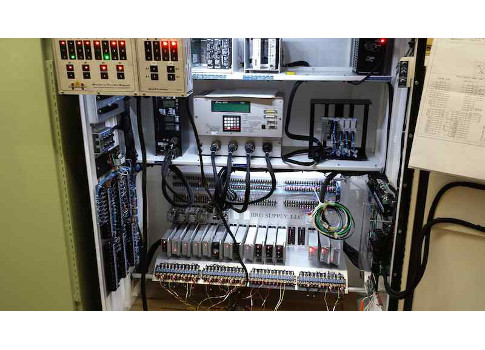PLCs work with traffic light controllers to help light-rail trains pass safely through intersections.

The City of Milpitas, Calif. wanted to integrate its new light-rail system with traffic light controls at four different four-way intersections (see Figure 1). The city wanted the trains to be able to pass through each intersection safely without slowing or stopping for vehicular traffic in normal operation. It also wanted to be able to tell the trains to stop when dictated by certain traffic signal and pedestrian conditions. Ideally, the new automation system should be able to sense the approach of a train, change the traffic signals to stop cross traffic, and allow the light-rail train to pass through without slowing.
Unfortunately, the existing traffic-light system could not accommodate the trains, so the city needed a new automation system that could perform the required functions.
The City of Milpitas purchased five IDEC MicroSmart Pentra PLCs with digital I/O modules, interfaced them to the traffic light controllers at each intersection, and achieved its objectives. The city chose this PLC because it is reliable, cost-effective, and capable of performing the required control. The PLC also has an Ethernet port to allow remote monitoring and communication, and the capability to expand as necessary.
Sensing trains
An approaching train activates the advance detector loop sensor, which sends a signal to the PLC. The PLC initiates a 15- to 25-sec delay depending on the time before the train is due to arrive at the intersection, which is a function of the train’s speed and the sensor’s distance from the intersection (see Figure 2).
The PLC instructs the traffic light controller to stop vehicular traffic through the intersection. As soon as the train hits the release loop sensor on the other side of the intersection, the PLC instructs the traffic signal controller to resume normal operations.
The PLC also detects all the traffic light changes made by the traffic light controller. If it sees that the traffic control system cannot change the lights in time-perhaps because pedestrian sensors detect the presence of people in the crosswalks-the PLC will send an output to a stop signal on the track to stop the train via a red-yellow-green train light. Each train has a human operator, who manually stops the train whenever the red light appears.
If a second train is coming from the opposite direction, the PLC will wait until both trains clear the intersection before allowing the traffic light controller to resume normal operation. The PLC can stop both trains if traffic congestion or other problems make it impossible to stop vehicular traffic.
After the PLC serves the trains, it waits until the traffic controller has served the opposing vehicle phases or directions. The PLC also monitors the train advance and release detectors, and if they lock up, the PLC will time out and resume normal operations until the next train comes. As determined by a software algorithm, the PLC can delay the train signals during peak hours to prevent traffic backup if more trains cross the intersection. This function is turned on by the PLC time clock running a time-of-day program.
Preparing the PLCs
The PLC chosen for this project is an open architecture device with 128 k of user program capacity. It allows a user to store, transfer, or upgrade the program memory using a miniature flash card. The PLC can handle up to 492 digital I/O and 42 analog I/O points. The Milpitas system required 52 discrete 24 V dc I/O, which were handled by the new PLC’s discrete I/O modules. Each intersection has a PLC, input modules, output modules, and associated components.
Systems integrator Angelo Lombardo programmed the PLCs using the manufacturer’s PC-based Automation Organizer Suite, primarily using the WindLDR ladder logic software, which is part of the suite of available programming tools. WindLDR has a built-in simulation mode, which allowed Lombardo to completely test the logic prior to installing the PLCs at the intersections.
The City of Milpitas’ traffic department installed the four PLCs in the enclosures that house the traffic light control systems, wired the track sensors to the PLCs, and wired I/O from the PLCs to the traffic control systems (see Figure 3).
Initial system testing was done late at night when minimal vehicular traffic was present; start-up went very well. Thanks to the software simulation, the PLC performed perfectly, and the only difficulties involved sensors and wiring issues.
Commissioning and start-up also went very smoothly. Even the required rewiring was not a major issue because the new PLC I/O uses the same wiring pins as the previous discrete logic box. A spreadsheet was provided showing the PLC’s pin, function, and termination points, which further simplified the required rewiring.
After start-up and commissioning, the only changes made to the program were to enhance traffic flow. These changes were related to train delay times, locked detector timers, and the time clock.
Because the selected PLC uses a miniature flash card to store program memory, it was a simple matter to download a fresh copy of the software for each of the PLCs (see Figure 4). This was done by changing the program at the first PLC, removing the flash card from the PLC, and installing the flash card at each of the other four PLCs in turn so that each could write the new program to its memory.
One interesting aspect of the installation was how easy it was to program the PLC to perform traffic light functions, and how difficult it was to modify the existing traffic light controllers. This suggests the possibility of someday replacing the traffic light controllers with PLCs, which would add flexibility to the traffic control system, as well as improve communications from the control system to the central traffic control and monitoring system.
While the PLCs don’t actually change the vehicle lights, there is no reason why they couldn’t. Although literally millions of such traffic light controllers are being used around the world, it’s quite possible that PLCs could take over many tasks in that industry-especially if a city plans to add advanced functions, such as accommodating light-rail train service.
Thai Nguyen is a traffic signal system operator and lighting electrician for the City of Milpitas, Calif. He has a degree in computer and electronics technology, is a certified International Municipal Signal Association Level 3 bench technician, and has worked for the city since 1999.
Angelo Lombardo is an independent systems integrator based in Sunnyvale, Calif.
This article appears in the Applied Automation supplement for Control Engineering and Plant Engineering.



